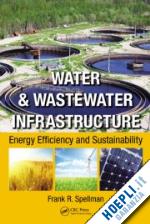A critical aspect of sustainability associated with water and wastewater systems is to maintain and manage infrastructure in the most efficient and economical manner while complying with environmental regulations and keeping rates at acceptable levels. Given the high cost of fuel, our growing population, and the associated increase in energy needs, it is important to address energy use and future energy availability for the treatment of the water we drink and the water we pollute. Water & Wastewater Infrastructure: Energy Efficiency and Sustainability addresses these issues, detailing the processes that can assist facilities to become more energy efficient and providing guidance to ensure their sustainability.The text begins with brief descriptions of the water and wastewater treatment industries. It then describes some of the basics of energy and discusses what planning for a sustainable energy future in water and wastewater treatment plants entails. The author explores energy-saving options and provides case studies to demonstrate how some facilities have used equipment, technology, and operating strategies to save money and reduce their impact. The energy-efficient technologies include combined heat and power (CHP), gas turbines, microturbines, reciprocating engines, steam turbines, and fuel cells. The author also addresses biomass power and biogas.The section on sustainability and renewable energy covers hydropower, solar power, and wind power as well as energy conservation measures for treating wastewater. Nine appendices provide individual case studies that present evaluations of energy conservation measures, results, payback analysis, and conclusions. This book addresses the challenges faced by water and wastewater treatment facilities by examining how they can operate in ways that provide economic and environmental benefits, save money, reduce environmental impact, and lead to sustainability.











